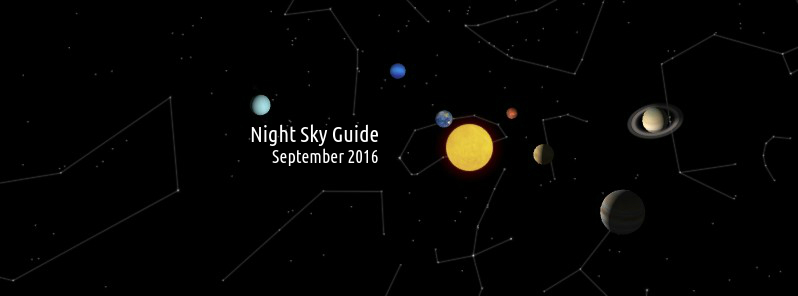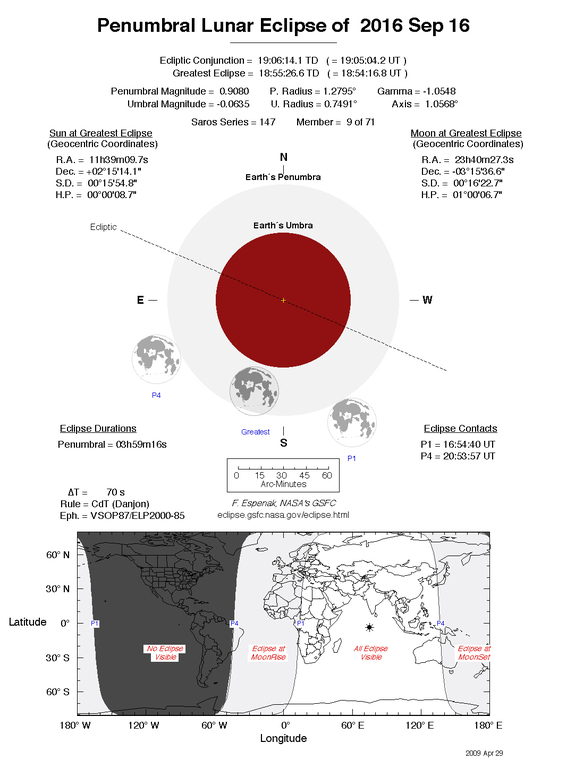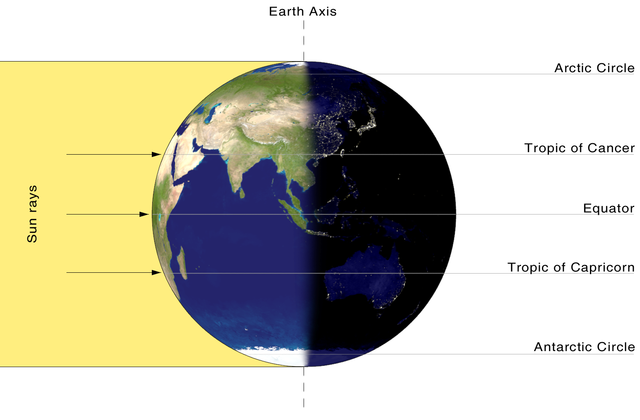Night sky guide for September 2016

September 2016 started with an annular solar eclipse visible across central Africa southwards to Madagascar and into the Indian Ocean. The next annular eclipse will occur on February 26, 2017, and will be visible from south and west Africa, much of South America, Pacific, Atlantic, Indian Ocean and Antarctica. The next total solar eclipse will occur on August 21, 2017, across North America.
This month's new moons are on September 1 and 30. Since there is no moonlight to interfere, new moons provide the best time of the month to observe faint objects such as galaxies and star clusters. The moon will be full on September 16.
On the same day, a penumbral lunar eclipse will occur. During this type of eclipse, the Moon will darken slightly but not completely. It will be visible throughout most of eastern Europe, eastern Africa, Asia, and western Australia.
The Sun will shine directly on the equator, and there will be nearly equal amounts of day and night throughout the world on September 22 – September equinox. This is also the first day of fall (autumnal equinox) in the northern hemisphere and the first day of spring (vernal equinox) in the southern hemisphere.
-
September 1 – New Moon – 09:03 UTC. The Moon will be located on the same side of the Earth as the Sun and will not be visible in the night sky. This is the best time of the month to observe faint objects such as galaxies and star clusters because there is no moonlight to interfere.
-
September 1 – Annular solar eclipse – 09:06 UTC. An annular solar eclipse occurs when the Moon is too far away from the Earth to completely cover the Sun. This results in a ring of light around the darkened Moon.

Video courtesy SciNews
-
September 2 – Neptune at Opposition – 16:23 UTC. Planet Neptune will be at its closest approach to Earth and its face will be fully illuminated by the Sun. It will be brighter than any other time of the year and will be visible all night long. This is the best time to view and photograph Neptune. Due to its extreme distance from Earth, it will only appear as a tiny blue dot in all but the most powerful telescopes.
-
September 8 – Conjunction between the Moon and Saturn – 22:05 UTC. The Moon and Saturn will make a close approach, passing within 3°46' of each other. At the moment of closest approach, the Moon will be at mag -11.7, and Saturn at mag 0.2, both in the constellation Ophiuchus. The pair will be too widely separated to fit within the field of view of a telescope, but will be visible to the naked eye or through a pair of binoculars.
-
September 13 – Mercury at inferior solar conjunction – 23:34 UTC. Mercury will pass very close to the Sun in the sky as its orbit carries it between the Sun and Earth. This occurs once in every synodic cycle of the planet (116 days) and marks the end of Mercury's apparition in the evening sky and its transition to become a morning object over the next few weeks. At closest approach, Mercury and the Sun will appear at a separation of only 3°23', making Mercury totally unobservable for several weeks while it is lost in the Sun's glare. Mercury will also pass perigee, the time when it is closest to the Earth, at around the same time, since it will lie on exactly the same side of the Sun as the Earth in the Solar System. It will move to within a distance of 0.64 AU from the Earth, making it appear with its largest angular size. If it could be observed, it would measure 10.5 arcsecs in diameter, whilst appearing completely unilluminated.
-
September 14 – Moon at aphelion – 07:54 UTC. The Moon's monthly orbit around the Earth will carry it to its furthest point from the Sun – its aphelion – at a distance of 1.0079 AU from the Sun. This happens at around the time when the Moon's orbit carries it around the far side of the Earth as seen from the Sun, at around the same time that it passes full moon. For comparison, at the moment of this aphelion, the Earth will lie at a distance of 1.0058 AU from the Sun, and at a distance of 0.0025 AU (375 000 km / 233 014 miles) from the Moon.
-
September 16 – Penumbral lunar eclipse – 18:55 UTC. A penumbral lunar eclipse occurs when the Moon passes through the Earth's partial shadow, or penumbra. During this type of eclipse, the Moon will darken slightly but not completely. The eclipse will be visible throughout most of eastern Europe, eastern Africa, Asia, and western Australia.


Image courtesy Fred Espenak, NASA/GSFC
-
September 16 – Full Moon – 19:06 UTC. At this time in its monthly cycle of phases, the Moon lies almost directly opposite the Sun in the sky, placing it high above the horizon for much of the night. The sequence of full moons through the year are often assigned names according to the seasons in which they fall. This month's full moon will be the third to fall in northern hemisphere's summer of 2016 – the Fruit Moon. This full moon was known by early Native American tribes as the Full Corn Moon because the corn is harvested around this time of year. This moon is also known as the Harvest Moon, the full moon that occurs closest to the September equinox each year. Over the nights following September 16, the Moon will rise around an hour later each day, becoming prominent later in the night. Within a few days, it will only be visible in the pre-dawn and early-morning sky. By the time it reaches last quarter, a week after full moon, it will rise at around midnight and set at around noon. At the exact moment when the Moon reaches full phase, it will lie at a declination of -03°18' in the constellation Aquarius, and so will appear high in the sky at all but the most extreme latitudes. It will be visible at all latitudes between 76°N and 83°S. Its distance from the Earth will be 364 000 km (226 179 miles).
-
September 18 – Moon at perigee – 17:01 UTC. The Moon will reach the closest point along its orbit to the Earth, and as a result will appear slightly larger than at other times. ItsThe Moon's distance from the Earth varies because its orbit is not perfectly circular – it is instead slightly oval-shaped, tracing out a path called an ellipse. As the Moon traverses this elliptical path around the Earth each month, its distance varies by around 10%, between 363 000 km (225 557 miles) and 405 000 km (251 655 miles). This means that its size in the night sky also varies over the course of each month, by around 13%. Its brightness also varies slightly – the Moon appears a little brighter when it is closer to the Earth. In practice, however, this variability is swamped by the much stronger effect that the Moon's changing phases have over its brightness. The perigee will occur when the Moon is close to full phase, and so it will appear fractionally larger and brighter than usual. On this occasion, the Moon will pass within a distance of 361 000 km (224 315 miles) of the Earth, and appear with an angular diameter of 33.00 arcsecs. This may be compared to its average size of 31.07 arcmins. The genuine variation in the Moon's angular size that is associated with its changing distance from the Earth should not be confused with the Moon illusion – an optical illusion that makes the Moon appear much larger than it really is when it is close to the horizon. The reason why we experience this optical illusion is still hotly debated.
-
September 18 – Conjunction between the Moon and Uranus – 18:13 UTC. The Moon and Uranus will make a close approach, passing within 2°48' of each other. At the moment of closest approach, the Moon will be at mag -12.7, and Uranus at mag 5.7, both in the constellation Pisces. The pair will be too widely separated to fit within the field of view of a telescope, but will be visible to the naked eye or through a pair of binoculars.
-
September 21 – Piscid meteor shower. The Piscid meteor shower will reach its maximum rate of activity on September 21, 2016, but some shooting stars associated with the shower are expected to be visible each night from September to October. The maximum rate of meteors expected to be visible from a dark location is around 5 per hour (ZHR). The Moon will be 20 days old at the time of peak activity, and so will present significant interference in the pre-dawn sky.
-
September 22 – September equinox – 14:14 UTC. The Sun will shine directly on the equator, and there will be nearly equal amounts of day and night throughout the world. This is also the first day of fall (autumnal equinox) in the northern hemisphere and the first day of spring (vernal equinox) in the southern hemisphere. Equinoxes occur twice a year – in March and September – once when the Sun is traveling northwards, and once when it is traveling southwards. The position of the Sun at the moment of the March equinox is used to define the zero point of both right ascension and declination. At the September equinox, the Sun lies exactly opposite this point, at a right ascension of around 12 hours. In practice, this is not exactly the case, because of a phenomenon called the precession of the equinoxes. Over hundreds of years, the direction of the Earth's spin axis in space changes because it acts like a gyroscope. This means that the location of the equinoxes creep across the sky at a rate of around 50 arcseconds each year. Astronomers quote right ascensions and declinations based on the configuration of the Earth's path around the Sun on January 1, 2000. Even in the years that have passed since the year 2000, the precession of the equinoxes has moved them by several arcminutes.


On the day of the equinox, the Earth's poles are not tilted towards or away from the Sun, meaning that the Sun is above the horizon for half the time at all latitudes. Image courtesy of Przemyslaw Idzkiewicz
-
September 24 – NGC 55 well placed for observation. NGC 55, a barred irregular galaxy in Sculptor will be well placed for observation. It will reach its highest point in the sky at around midnight local time. At a declination of -39°10', it is easiest to see from the southern hemisphere and cannot be seen from latitudes much north of 30°N. At magnitude 8.0, NGC55 is quite faint, and certainly not visible to the naked eye, but can be viewed through a pair of binoculars or a small telescope.
-
September 26 – 47-Tuc (NGC 104) well placed for observation. The second brightest globular cluster in the sky, 47-Tuc (NGC 104), in Tucana will be well placed for observation. It will reach its highest point in the sky at around midnight local time. At a declination of -72°04', it is easiest to see from the southern hemisphere and cannot be seen from latitudes much north of 2°S. At magnitude 4.0, 47-Tuc is tricky to make out with the naked eye except from a dark site, but is visible through a pair of binoculars or a small telescope.
-
September 26 – Jupiter at solar conjunction – 07:05 UTC. From our vantage point on the Earth, Jupiter will appear very close to the Sun in the sky as it passes around the far side of the solar system from the Earth. At closest approach, Jupiter and the Sun will appear at a separation of only 1°05', making Jupiter totally unobservable for several weeks while it is lost in the Sun's glare. At around the same time, Jupiter will also be at its most distant from the Earth – receding to a distance of 6.45 AU – since the two planets will lie on opposite sides of the solar system. If Jupiter could be observed at this time, it would appear at its smallest and faintest on account of its large distance. It would measure 29.9 arcsecs in diameter. Over following weeks and months, Jupiter will re-emerge to the west of the Sun, gradually becoming visible for ever-longer periods in the pre-dawn sky. After around six months, it will reach opposition, when it will be visible for virtually the whole night.
-
September 28 – Mercury at perihelion – 15:23 UTC. Mercury's 88-day orbit around the Sun will carry it to its closest point to the Sun – its perihelion – at a distance of 0.31 AU from the Sun. Unlike most of the planets, which follow almost exactly circular orbits around the Sun only varying in their distance from the Sun by a few percent, Mercury has a significantly elliptical orbit. Its distance from the Sun varies between 0.307 AU at perihelion (closest approach to the Sun), and 0.467 AU at aphelion (furthest recess from the Sun). This variation, of over 50%, means that its surface receives over twice as much energy from the Sun at perihelion as compared to aphelion. However, this makes little difference to Mercury's telescopic appearance, since little if any detail on its surface can be resolved by ground-based telescopes. Although its changing seasons have an incredible effect upon its surface temperatures, there is little change that is visible to amateur observers.
-
September 28 – Mercury at greatest elongation west. The planet Mercury reaches greatest western elongation of 17.9 degrees from the Sun. This is the best time to view Mercury since it will be at its highest point above the horizon in the morning sky. Look for the planet low in the eastern sky just before sunrise.
-
September 29 – Asteroid 11 Parthenope at opposition – 08:35 UTC. Asteroid 11 Parthenope will be well placed for observation, lying in the constellation Cetus, well above the horizon for much of the night. Regardless of your location on the Earth, 11 Parthenope will reach its highest point in the sky at around midnight local time.
-
September 30 – New moon – 00:13 UTC. The Moon will be located on the same side of the Earth as the Sun and will not be visible in the night sky. This is the best time of the month to observe faint objects such as galaxies and star clusters because there is no moonlight to interfere.
-
September 30 – M110 well placed for observation. M110, the brightest satellite galaxy of the Andromeda galaxy (M31) will be well placed for observation. It will reach its highest point in the sky at around midnight local time. At a declination of +41°40', it is easiest to see from the northern hemisphere and cannot be seen from latitudes much south of 28°S. At magnitude 8.0, M110 is quite faint, and certainly not visible to the naked eye, but can be viewed through a pair of binoculars or a small telescope.


Video courtesy Hubble Space Telescope
Sources: InTheSky (Dominic Ford), SeaSky
Featured image background credit Solar System Scope – September 1, 2016. Edit: TW

On September 4th 2016 as the moon came up I notice it looked like double moons, one slightly above the other, I took a picture of it, Does anyone know why this happened?